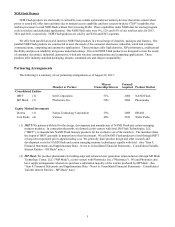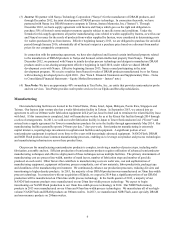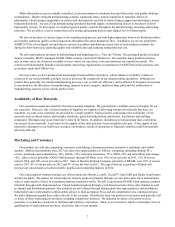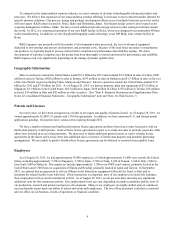Crucial 2013 Annual Report Download - page 16
Download and view the complete annual report
Please find page 16 of the 2013 Crucial annual report below. You can navigate through the pages in the report by either clicking on the pages listed below, or by using the keyword search tool below to find specific information within the annual report.15
Our acquisitions of Elpida and Rexchip expose us to significant risks from changes in currency exchange rates.
Under the Sponsor Agreement, we committed to support plans of reorganization for Elpida that provide for payments to the
secured and unsecured creditors of Elpida in an aggregate amount of 200 billion yen. The U.S. dollar amount of this payment
obligation could increase if the yen strengthens against the U.S. dollar. Additionally, a significant portion of Elpida's and
Rexchip's operating costs are paid in Yen and New Taiwan dollars so our operating results subsequent to the acquisition could
also be adversely impacted if these currencies strengthen against the U.S. dollar.
Our acquisitions of Elpida and Rexchip may increase our risk of significant deficiencies or material weaknesses in our
internal controls over financial reporting.
Elpida and Rexchip have not performed an assessment of the effectiveness of the design and operation of their internal
control over financial reporting. In addition, Elpida and Rexchip have not historically prepared their financial statements under
U.S. generally accepted accounting standards. Elpida and Rexchip were not required to be included in our assessment of
internal controls for 2013 but will be included in our assessment for 2014, which may increase our risk for material weaknesses
in our internal control over financial reporting.
Debt obligations could adversely affect our financial condition.
We are engaged in a capital intensive business subject to significant changes in supply and demand and product pricing and
recent periods of consolidation, any of which could result in our incurrence or assumption of indebtedness. In recent periods,
our debt levels have increased. As of August 29, 2013, we had $6.0 billion of debt, including $485 million principal amount of
convertible senior notes due in 2014. As of August 29, 2013, we had two credit facilities available that provides for up to $408
million of additional financing, subject to outstanding balances of trade receivables and other conditions. Events and
circumstances may occur which would cause us to not be able to satisfy the applicable drawdown conditions and utilize either
of these facilities. We have in the past and expect in the future to continue to incur additional debt to finance our capital
investments, including debt incurred in connection with asset-backed financing.
The plans of reorganization of the Elpida Companies provide for payments by the Elpida Companies to their secured and
unsecured creditors in an aggregate amount of 200 billion yen (or the equivalent of approximately $2.05 billion), less certain
expenses of the Japan Proceedings and certain other items. If the resolution of certain unfixed claims under the plans of
reorganization, primarily comprised of outstanding litigation claims, would result in payments in respect of those claims in
excess of amounts reserved under the plans of reorganization to satisfy such claims, there is a possibility that the Elpida
Companies would be required to pay more than 200 billion yen to their pre-petition creditors under the plans of reorganization.
In addition, if these unfixed claims are resolved pursuant to settlement arrangements or other post-petition agreements, a
substantial portion of the amounts payable with respect to the claims may have to be funded by the Elpida Companies outside
of the installment payments provided for by the plans of reorganization.
Our debt and our guarantee obligations could adversely impact us. For example, these obligations could:
• require us to use a large portion of our cash flow to pay principal and interest on debt, which will reduce the amount of
cash flow available to fund working capital, capital expenditures, acquisitions, research and development expenditures
and other business activities;
• limit our future ability to raise funds for capital expenditures, strategic acquisitions or business opportunities, research
and development and other general corporate requirements;
• contribute to a future downgrade of our credit rating, which could increase future borrowing costs; and
• increase our vulnerability to adverse economic and semiconductor memory industry conditions.
Our ability to meet our payment obligations under our debt instruments depends on our ability to generate significant cash
flow in the future. This, to some extent, is subject to general economic, financial, competitive, legislative and regulatory factors
as well as other factors that are beyond our control. There can be no assurance that our business will generate cash flow from
operations, or that additional capital will be available to us, in an amount sufficient to enable us to meet our debt payment
obligations and to fund other liquidity needs. If we are unable to generate sufficient cash flow to service our debt obligations,
we may need to refinance or restructure our debt, sell assets, reduce or delay capital investments, or seek to raise additional
capital. If we were unable to implement one or more of these alternatives, we may be unable to meet our debt payment
obligations, which could have a material adverse effect on our business and results of operations.
























